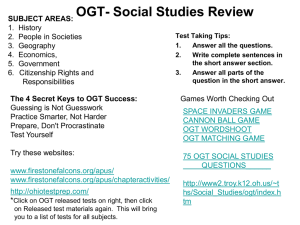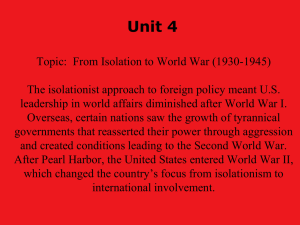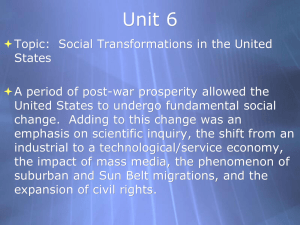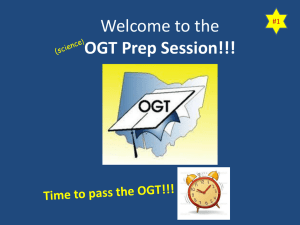Compiled by A. Crabtree, 2006
advertisement
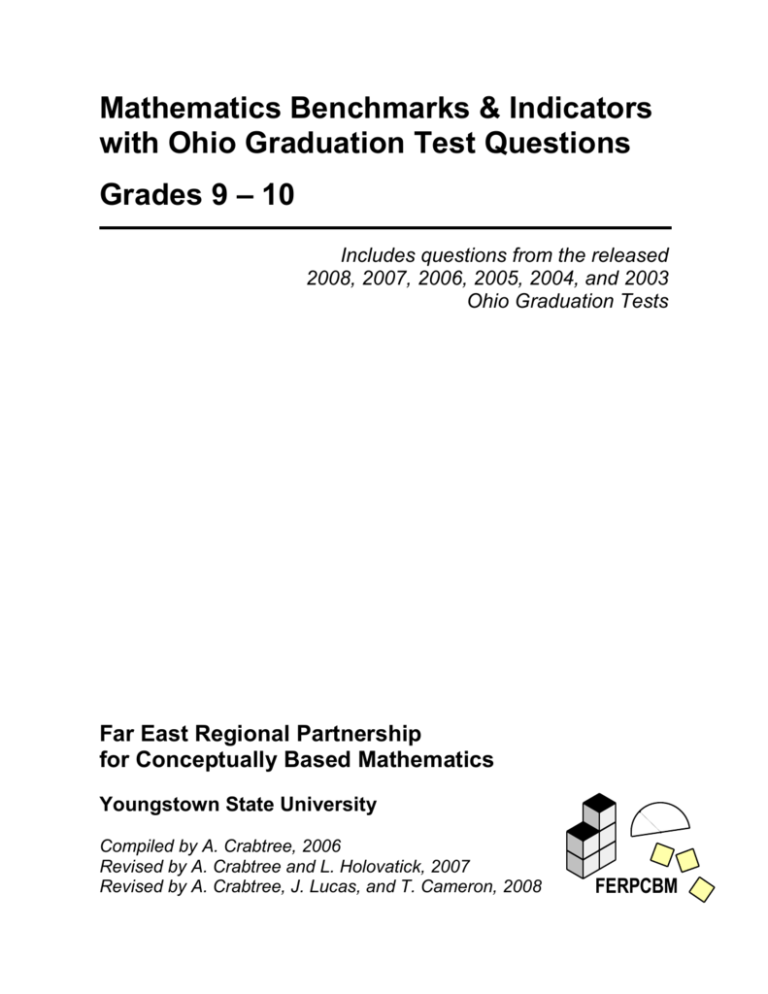
Mathematics Benchmarks & Indicators with Ohio Graduation Test Questions Grades 9 – 10 Includes questions from the released 2008, 2007, 2006, 2005, 2004, and 2003 Ohio Graduation Tests Far East Regional Partnership for Conceptually Based Mathematics Youngstown State University Compiled by A. Crabtree, 2006 Revised by A. Crabtree and L. Holovatick, 2007 Revised by A. Crabtree, J. Lucas, and T. Cameron, 2008 FERPCBM Geometry and Spatial Sense Standard Geometry and Spatial Sense OGT Problems A. Formally define geometric figures. 10.1. Formally define and explain key aspects of geometric figures, including: a. interior and exterior angle of polygons; b. segments related to triangles (median, altitude, midsegment); c. points of concurrency related to triangles (centroid, incenter, orthocenter, and circumcenter); d. circles (radius, diameter, chord, circumference, major arc, minor arc, sector, segment, inscribed angle). 10.2. Recognize and explain the necessity for certain terms to remain undefined, such as point, line and place. 10.6. Identify the reflection and rotation symmetries of two- and three-dimensional figures. 10.10. Solve problems involving chords, radii, and arcs within the same circle. OGT 2007 – Problem #10 The diagram below shows two of the faces of a prism. Ellen is constructing this triangular prism out of cardboard. Ellen plans to draw a shape (a net of the prism) on a piece of cardboard that she can cut out and fold to make the prism. In your Answer Document, sketch a net of the prism that Ellen could use. Place the dimensions on the net. Prepared by Aimee Crabtree for FERPCBM, Youngstown, Ohio Benchmarks with OGT Problems Summer 2006 (Rev. 2008) Page 3 of 36 Geometry and Spatial Sense OGT Problems OGT 2007 – Problem # 33 The figure shows a three-dimensional object when viewed from above. A. pentagonal pyramid B. rectangular prism C. square pyramid D. triangular prism Which of these objects could the sketch represent? OGT 2005 – Problem # 3 Joseph plans to tile his kitchen floor. All the tiles will be identical regular polygons. Joseph wants three tiles to meet at each vertex with no space left over. A. pentagon B. hexagon C. triangle D. square What shape of tile should he use? OGT 2004 – Problem # 13 Daniel cut the corner off a cube as shown in the diagram below. A. cone B. cube C. triangular prism D. triangular pyramid Points A, B and C are the midpoints of the edges of the cube. What type of three dimensional figure has been cut off? Prepared by Aimee Crabtree for FERPCBM, Youngstown, Ohio Benchmarks with OGT Problems Summer 2006 (Rev. 2008) Page 4 of 36 Geometry and Spatial Sense OGT Problems OGT 2003 – Problem #5 Four points are connected with line segments, as shown on the coordinate plane below. In your Answer Document, find the slope of each side. Determine if the shape is a parallelogram. Show your work or provide an explanation to support your answer. Prepared by Aimee Crabtree for FERPCBM, Youngstown, Ohio Benchmarks with OGT Problems Summer 2006 (Rev. 2008) Page 5 of 36 Geometry and Spatial Sense OGT Problems OGT 2003 – Problem #21 The Venn diagram below represents relationships among various kinds of triangles. Which of the following triangles is included in the shaded region? Prepared by Aimee Crabtree for FERPCBM, Youngstown, Ohio Benchmarks with OGT Problems Summer 2006 (Rev. 2008) Page 6 of 36 Geometry and Spatial Sense OGT Problems B. Describe and apply the properties of similar and congruent figures; and justify conjectures involving similarity and congruence. OGT 2008 – Problem # 37 An airline executive drew a sketch of a logo on a napkin. 4 .0 y 3.8 10.0 3 .8 6 . 8 B. y 10 6 .8 y C. 4.0 10.0 y 10.0 D. 6 .8 3 . 8 A. She gave the logo to a graphic designer so he could make a mathematically similar version with a computer drawing program. The center line of the new logo needs to be 10 centimeters long. Which of these proportions could the graphic designer use to find the value of y? Prepared by Aimee Crabtree for FERPCBM, Youngstown, Ohio Benchmarks with OGT Problems Summer 2006 (Rev. 2008) Page 7 of 36 Geometry and Spatial Sense OGT Problems OGT 2007 – Problem # 29 Points E, F, G, and H are midpoints of the sides of quadrilateral ABCD. A. 96 If AC = 12 and BD = 8, what is the perimeter of quadrilateral EFGH? C. 20 B. 40 D. 4 OGT 2006 – Problem # 37 A. 37° B. 45° C. 53° D. 74° What is the measure of angle D? Prepared by Aimee Crabtree for FERPCBM, Youngstown, Ohio Benchmarks with OGT Problems Summer 2006 (Rev. 2008) Page 8 of 36 Geometry and Spatial Sense OGT Problems OGT 2005 – Problem # 23 The shadow cast by a one-foot ruler is 8 inches long. At the same time, the shadow cast by a pine tree is 24 feet long. A. 3 feet B. 16 feet C. 36 feet D. 192 feet What is the height, in feet, of the pine tree? OGT 2004 – Problem # 36 A student shines a light through a cutout of a triangle held parallel to a wall several feet straight in front of him, producing a similar image on the wall. What must the two triangles have in common? A. equal areas B. equal heights C. corresponding sides that are congruent D. corresponding angles that are congruent Prepared by Aimee Crabtree for FERPCBM, Youngstown, Ohio Benchmarks with OGT Problems Summer 2006 (Rev. 2008) Page 9 of 36 Geometry and Spatial Sense OGT Problems OGT 2003 – Problem #32 The angle of the roof on Kaya’s dollhouse is 56°. She built a scale model of the dollhouse with a scale ratio of 1 : 4. What is the measure of the angle of the roof of the model? A. 14° B. 34° C. 56° D. 224° C. Recognize and apply angle relationships in situations involving intersecting lines, perpendicular lines and parallel lines. 10.10. Solve problems involving chords, radii, and arcs within the same circle. OGT 2008 – Problem # 42 When a marble hits a wall, it bounces off the wall at the same angle it hits the wall. A. 44° B. 68° C. 136° D. 15 8° If a marble hits a wall at a 22 degree angle, what is the measure of the angle between the two paths of the marble? Prepared by Aimee Crabtree for FERPCBM, Youngstown, Ohio Benchmarks with OGT Problems Summer 2006 (Rev. 2008) Page 10 of 36 Geometry and Spatial Sense OGT Problems OGT 2007 – Problem # 25 In which figure is the measure of 1 not equal to 60°? OGT 2006 – Problem # 25 A worker painted stripes for spaces in a parking lot. The worker first painted a center stripe that marked the front of the parking spaces. Then he painted parallel stripes marking the sides. A. 2 and 3 B. 2 and 5 C. 3 and 5 D. 4 and 5 Which angles will be congruent to angle 1 if all the side stripes are parallel? Prepared by Aimee Crabtree for FERPCBM, Youngstown, Ohio Benchmarks with OGT Problems Summer 2006 (Rev. 2008) Page 11 of 36 Geometry and Spatial Sense OGT Problems OGT 2005 – Problem # 1 Ms. Chen drew a diagram for a new patio in her backyard. OGT 2003 – Problem #1 When framing in a wall, carpenters make sure that all vertical studs are perpendicular to the floor and ceiling. They sometimes add a diagonal brace for added support during construction (as shown in the drawing). When the vertical studs are perpendicular to the floor, which pair of angles will always be congruent? Prepared by Aimee Crabtree for FERPCBM, Youngstown, Ohio Benchmarks with OGT Problems Summer 2006 (Rev. 2008) Page 12 of 36 Geometry and Spatial Sense OGT Problems D. Use coordinate geometry to represent and examine the properties of geometric figures. OGT 2008 – Problem # 13 The coordinates of triangle KLM are K: (–2, –5), L: (0, 1) and M: (6, –2). What type of triangle is KLM? A. obtuse isosceles B. acute scalene C. right isosceles D. right scalene Prepared by Aimee Crabtree for FERPCBM, Youngstown, Ohio Benchmarks with OGT Problems Summer 2006 (Rev. 2008) Page 13 of 36 Geometry and Spatial Sense OGT Problems OGT 2006 – Problem # 29 Three vertices of a quadrilateral are (–1, –1), (1, 2) and (5, 2). A. (3, 0) B. (3, –2) C. (–5, 0) D. (7, –1) When used as the last vertex, which point would make the quadrilateral a trapezoid? OGT 2005 – Problem # 35 The vertices of a quadrilateral are (2, 2), (4, 6), (8, 2), and (10, 6). Which describes this quadrilateral? A. parallelogram B. rectangle C. rhombus D. square OGT 2005 – Problem # 41 An electronics engineer is programming the computer that controls the circuit board cutting tools. He enters the coordinates of the vertices of a rectangular circuit board. The first three coordinates are (2, 0), (2, 6) and (6, 6). A. (0, 2) B. (0, 6) C. (6, 0) D. (6, 2) What are the coordinates of the fourth vertex? Prepared by Aimee Crabtree for FERPCBM, Youngstown, Ohio Benchmarks with OGT Problems Summer 2006 (Rev. 2008) Page 14 of 36 Geometry and Spatial Sense OGT Problems OGT 2004 – Problem # 30 Points P, Q and R are shown below. These points are three vertices of a parallelogram. What are the coordinates of the fourth vertex of parallelogram PQRS? A. (4, 6) B. (5, 2) C. (8, –1) D. (9, 1) Prepared by Aimee Crabtree for FERPCBM, Youngstown, Ohio Benchmarks with OGT Problems Summer 2006 (Rev. 2008) Page 15 of 36 Geometry and Spatial Sense OGT Problems OGT 2003 – Problem #5 Four points are connected with line segments, as shown on the coordinate plane below. In your Answer Document, find the slope of each side. Determine if the shape is a parallelogram. Show your work or provide an explanation to support your answer. OGT 2003 – Problem #38 A circle is sketched on a coordinate plane with the center at (6, 8). The circle passes through the point (0, 5). Which of these expressions could be used to find r , the radius of the circle? Prepared by Aimee Crabtree for FERPCBM, Youngstown, Ohio Benchmarks with OGT Problems Summer 2006 (Rev. 2008) Page 16 of 36 Geometry and Spatial Sense OGT Problems E. Draw and construct representations of two- and three-dimensional geometric objects using a variety of tools, such as straightedge, compass and technology. 10.4. Construct right triangles, equilateral triangles, parallelograms, trapezoids, rectangles, rhombuses, squares and kites, using compass and straightedge or dynamic geometry software. 10.5. Construct congruent or similar figures using tools, such as compass, straightedge, and protractor or dynamic geometry software. 10.7. Perform reflections and rotations using compass and straightedge constructions and dynamic geometry software. OGT 2008 – Problem # 4 The figure shows two views of the same object. Which net will make the figure shown? Prepared by Aimee Crabtree for FERPCBM, Youngstown, Ohio Benchmarks with OGT Problems Summer 2006 (Rev. 2008) Page 17 of 36 Geometry and Spatial Sense OGT Problems OGT 2007 – Problem # 6 The net creates a pyramid. Which pyramid does this net create? OGT 2007 – Problem #10 The diagram below shows two of the faces of a prism. Ellen is constructing this triangular prism out of cardboard. Ellen plans to draw a shape (a net of the prism) on a piece of cardboard that she can cut out and fold to make the prism. In your Answer Document, sketch a net of the prism that Ellen could use. Place the dimensions on the net. Prepared by Aimee Crabtree for FERPCBM, Youngstown, Ohio Benchmarks with OGT Problems Summer 2006 (Rev. 2008) Page 18 of 36 Geometry and Spatial Sense OGT Problems OGT 2006 – Problem # 11 The figure shows the net for a three-dimensional object. When folded, which object will this net produce? OGT 2003 – Problem #13 Penny needs to make a model of an Egyptian pyramid for her history class. She plans to cut a shape out of thick cardboard and then fold it to make a pyramid with a square base. Which of these nets or shapes could Penny use to make her model? Prepared by Aimee Crabtree for FERPCBM, Youngstown, Ohio Benchmarks with OGT Problems Summer 2006 (Rev. 2008) Page 19 of 36 Geometry and Spatial Sense OGT Problems F. Represent and model transformations in a coordinate plane and describe the results. 10.8. Derive coordinate rules for translations, reflections and rotations of geometric figures in the coordinate plane. 10.9. Show and describe the results of combinations of translations, reflections and rotations (compositions); e.g., perform compositions and specify the result of a composition as the outcome of a single motion, when applicable. OGT 2008 – Problem # 34 The vertices of Triangle I are (1, 3), (2, 1) and (5, 0). Triangle I is reflected across the x-axis, resulting in Triangle II. Triangle II is then rotated 180o about the origin, resulting in Triangle III. In your Answer Document, draw and label Triangles I, II and III on the same coordinate plane. Describe a single transformation that would map Triangle I directly onto Triangle III. OGT 2007 – Problem # 37 The quadrilateral below is to be translated 6 units to the right and 3 units down. A. (3, –4) B. (3, –1) C. (3, 2) D. (1, –1) Which ordered pair is not the coordinates for a vertex of the translated image? Prepared by Aimee Crabtree for FERPCBM, Youngstown, Ohio Benchmarks with OGT Problems Summer 2006 (Rev. 2008) Page 20 of 36 Geometry and Spatial Sense OGT Problems OGT 2007 – Problem # 42 Jake is using a computer program to design parts for a new car. He has outlined one-half of a part on a coordinate grid. Rather than drawing the second half, he plans to have the computer reflect this shape over the y-axis. A. (0, 0); (0, 2); (−1, 3); (−2, 3); (−2, 0) B. (0, 0); (0, 3); (−1, 3); (−2, 2); (−2, 0) C. (0, 0); (0, −3); (1, −3); (2, −2); (2, 0) D. (0, 0); (0, −3); (−1, −3); (−2, −2); (−2, 0) Which of the following represents the 5 vertices of the reflected shape? OGT 2005 – Problem # 6 By the end of summer vacation, Callie had completed one-fourth of a quilt, as shown in the diagram below. To finish the quilt, Callie plans to reflect the design of the completed portion over lines p and q until all 4 portions are complete. In your Answer Document, copy the diagram above. Add the reflections of the completed portion of the quilt on the same sketch to show how the entire quilt will look when it is finished. Prepared by Aimee Crabtree for FERPCBM, Youngstown, Ohio Benchmarks with OGT Problems Summer 2006 (Rev. 2008) Page 21 of 36 Geometry and Spatial Sense OGT Problems OGT 2004 – Problem # 10 Triangle DEF has vertices with coordinates D(–2, 1), E(1, 5) and F(2, 3). In your Answer Document, draw and label triangle DEF on the grid provided. Draw the triangle D′E′F′ by translating each vertex of triangle DEF three units to the right and two units down. Appropriately label triangle D′E′F′. Draw the triangle D′′E′′F′′ by translating each vertex of triangle D′E′F′ two units to the left and seven units up. Appropriately label triangle D′′E′′F′′. Describe the movements necessary to perform a single translation of each vertex from triangle DEF to triangle D′′E′′F′′. OGT 2003 – Problem #28 The quadrilateral STUW has vertices at the coordinates (1, 1), (2, 5), (5, 5), and (8, 1), as shown. What are the coordinates of the vertices of quadrilateral STUW when it is reflected over the x-axis? A. (1, 1), (2, 5), (5, 5), (8, 1) B. (–1, 1), (–2, 5), (–5, 5), (–8, 1) C. (–1, –1), (–2, –5), (–5, –5), (–8, –1) D. (1, –1), (2, –5), (5, –5), (8, –1) Prepared by Aimee Crabtree for FERPCBM, Youngstown, Ohio Benchmarks with OGT Problems Summer 2006 (Rev. 2008) Page 22 of 36 Geometry and Spatial Sense OGT Problems G. Prove or disprove conjectures and solve problems involving two- and threedimensional objects represented within a coordinate system. 9.3. Analyze two-dimensional figures in a coordiante plane; e.g., use slope and distance formulas to show that a quadrilateral is a parallelogram. OGT 2006 – Problem # 40 Triangle ABC is shown on the graph. In your Answer Document, show that the segment connecting the midpoints of and is parallel to and one-half its length. Show your work or provide an explanation for your answer. H. Establish the validity of conjectures about geometric objects, their properties and relationships by counter-example, inductive and deductive reasoning, and critiquing arguments made by others. 10.3. Make, test and establish the validity of conjectures about geometric properties and relationships using counterexample, inductive and deductive reasoning, and paragraph or two-column proof, including: a. prove the Pythagoaren Theorem; b. prove theorems involving triangle similarity and congruence; c. prove theorems involving properties of lines, angles, triangles and quadrilaterals; d. test a conjecture using basic constructions made with a compass and straightedge or technology. 10.10. Solve problems involving chords, radii and arcs within the same chords. Prepared by Aimee Crabtree for FERPCBM, Youngstown, Ohio Benchmarks with OGT Problems Summer 2006 (Rev. 2008) Page 23 of 36 Geometry and Spatial Sense OGT Problems OGT 2004 – Problem # 33 Which figure is not a parallelogram? OGT 2003 – Problem #7 Josie claimed that all polyhedra have more vertices than faces. Which of these polyhedra shows that Josie’s statement is not always true? Prepared by Aimee Crabtree for FERPCBM, Youngstown, Ohio Benchmarks with OGT Problems Summer 2006 (Rev. 2008) Page 24 of 36 Geometry and Spatial Sense I. OGT Problems Use right triangle trigonometric relationships to determine lengths and angle measures. 9.1. Define the basic trigonometric ratios in right triangles: sine, cosine, and tangent. 9.2. Apply proportions and right triangle trigonometric ratios to solve problems involving missing lengths and angle sizes in similar figures. OGT 2005 – Problem # 15 Susan is flying a kite behind her house. She drops her string holder, and the kite gets caught in the top of a tree. A. 63 feet B. 65 feet C. 74 feet D. 87 feet If the string makes a 44° angle with the ground, and the holder is 90 feet from the base of the tree, how tall is the tree, rounded to the nearest whole foot? OGT 2003 – Problem #40 A yacht is anchored 90 feet offshore from the base of a lighthouse. The angle of elevation from the boat to the top of the lighthouse is 26 degrees. The distance between the yacht and the top of the lighthouse is about 100 feet. A. 25 feet B. 45 feet C. 110 feet D. 135 feet Which of these is nearest to the height of the lighthouse? Prepared by Aimee Crabtree for FERPCBM, Youngstown, Ohio Benchmarks with OGT Problems Summer 2006 (Rev. 2008) Page 25 of 36 Geometry and Spatial Sense Standard ♦ Answer Key Geometry and Spatial Sense – Answer Key OGT Problems Geometry and Spatial Sense A B C D E Geometry and Spatial Sense Test Year 2007 Question # 10 Answer S.A. Test Year 2003 Question # 13 Answer B 2007 33 C 2008 34 E.R. 2005 3 B 2007 37 B 2004 13 D 2007 42 B 2003 5 S.A.** 2005 6 S.A. 2003 21 B 2004 10 E.R. 2008 37 C 2003 28 D 2007 29 C 2006 40 E.R. 2006 37 A 2004 33 A 2005 23 C 2003 7 B 2004 36 D 2005 15 D 2003 32 C 2003 40 B 2008 42 C 2007 25 A 2006 25 C 2005 1 A 2003 1 C 2008 13 B 2006 29 D 2005 35 A 2005 41 C 2004 30 A 2003 5 S.A.** 2003 38 A 2008 4 A 2007 6 B 2007 10 S.A. 2006 11 D F G H I ** Scoring Rubric Not Released Prepared by Aimee Crabtree for FERPCBM, Youngstown, Ohio Benchmarks with OGT Problems Summer 2006 (Rev. 2008) Page 27 of 36 Geometry and Spatial Sense – Answer Key OGT Problems GSS – Benchmark F 2008 OGT – Problem # 34 Scoring Guidelines: Sample Response The reflection of Triangle I over the y-axis. Points Description 4 The focus of this item is to show and describe the results of combinations of translations, reflections and rotations. The response contains the correct three triangles labeled I, II and III on the same coordinate grid and contains the correct single transformation that maps Triangle I to Triangle III. 3 The response clearly addresses the key aspects of the task; however, it includes minor flaws. For example, the response may: - Contain the original triangle and the two transformations. Triangles are labeled I, II and III. But the response contains an incorrect or missing description of the single transformation that maps Triangle I to Triangle III. - Contain a single error in drawing the triangles. (Any subsequent transformations are consistent with the error.) The single transformation that maps the student’s Triangle I to the student’s Triangle III is based on the triangles. - Contain three correct triangles and a correct description of the single transformation that maps Triangle I to Triangle III. However, the triangles are not labeled, and the triangles are placed on separate coordinate systems. Prepared by Aimee Crabtree for FERPCBM, Youngstown, Ohio Benchmarks with OGT Problems Summer 2006 (Rev. 2008) Page 28 of 36 Geometry and Spatial Sense – Answer Key 2 OGT Problems The response provides evidence of a partially correct answer and/or solution process. The response may adequately address some of the components of the task but contain gaps or flaws in other components. For example, the response may: - Contain Triangle I drawn correctly and one correct transformation. The description of a single transformation from Triangle I to III is incorrect or missing. - Contain an incorrect Triangle I, but both of the transformations based on the student’s Triangle I are correct. The description of a single transformation from Triangle I to III is incorrect or missing. - Contain three correct triangles. But the description of a single transformation from Triangle I to III is incorrect or missing, the labeling is missing and the triangles are placed on separate coordinate systems. - Contain Triangle I drawn correctly, but both of the transformations are incorrect; however, the description is correct based on Triangle I and the student’s Triangle III. 1 The response omits significant aspects of the task. There is evidence of minimal understanding of the concepts involved in the task and/or solution process; however, the response includes significant errors in most of the components of the task. For example, the response may: - Show Triangle I correctly graphed, but both transformations are incorrect or missing. - Describe the correct movements necessary for a single transformation, but the graphs are omitted or incorrect. - Show a minimal understanding by completing one of the required transformations. - Contain an appropriate description of the transformation from the student’s Triangle I to the student’s Triangle III. 0 The response indicates inadequate understanding of the task, and the response does not meet the criteria required to earn one point. For example, the response may: - Contain an incorrect drawing of Triangle I and an incorrect attempt at performing the two transformations on the student’s Triangle I. - Recopy information provided in the question with no work toward a solution. - Be blank or the student writes “I do not know” or includes unrelated statements or work. Prepared by Aimee Crabtree for FERPCBM, Youngstown, Ohio Benchmarks with OGT Problems Summer 2006 (Rev. 2008) Page 29 of 36 Geometry and Spatial Sense – Answer Key OGT Problems GSS – Benchmarks A and E 2007 OGT – Problem # 10 Scoring Guidelines: Sample Response OR Nets – 1020 Prepared by Aimee Crabtree for FERPCBM, Youngstown, Ohio Benchmarks with OGT Problems Summer 2006 (Rev. 2008) Page 30 of 36 Geometry and Spatial Sense – Answer Key Points OGT Problems Description 2 The focus of the item is to sketch a net of a triangular prism with given dimensions. The response shows a sketch of a net with dimensions labeled appropriately. 1 The response provides evidence of a partially correct answer and/or solution process. The response shows understanding of some key elements of the task but contains gaps or flaws. For example, the response may: Contains a correct net but one or more of the dimensions is labeled incorrectly or missing. Contains a slightly flawed net (e.g., the student may omit the second triangle, or place the rectangles in an order that does not correspond to the order of the sides of the triangle.) 0 The response indicates inadequate understanding of the task and the response does not meet the criteria required to earn one point. For example, the response may: • Include unrelated statements or work. Prepared by Aimee Crabtree for FERPCBM, Youngstown, Ohio Benchmarks with OGT Problems Summer 2006 (Rev. 2008) Page 31 of 36 Geometry and Spatial Sense – Answer Key OGT Problems GSS – Benchmark G 2006 OGT – Problem # 40 Scoring Guidelines: Sample Response OR Student may provide a graphic solution by locating the midpoints and showing that the “rise over run” is the same for both the midpoint segment and the line and demonstrating that length of the midpoint segment is half the length of side AC using the Pythagorean theorem or similar triangles. OR There is a geometric theorem which states a segment joining the midpoints of two sides of a triangle is parallel to and equal to 1/2 the length of the third side of the triangle. Points Description 4 The focus of this item is the use of coordinate geometry to demonstrate relationships within a geometric figure. The response provides a demonstration that the mid-segment is parallel to and one-half the length of side AC by finding the midpoints of AB and BC and comparing the slope and length of the segment formed with the slope and length of AC or by completely stating the theorem. 3 The response clearly addresses the key aspects of the task; however, it includes errors in completing one or two components. For example, the response may: Correctly locate the midpoints and successfully demonstrate one half of the relationship. For the other part, the response demonstrates a correct procedure but contains computational errors or a minor graphing error Prepared by Aimee Crabtree for FERPCBM, Youngstown, Ohio Benchmarks with OGT Problems Summer 2006 (Rev. 2008) Page 32 of 36 Geometry and Spatial Sense – Answer Key OGT Problems (e.g., miscopies initial graph, but correctly demonstrates relationship). 2 The response provides evidence of a partially correct answer and/or solution process. The response may adequately address some of the components of the task, but contain gaps or flaws in other components. For example, the response may: Correctly locate the midpoints and demonstrate an attempt to compare both slope and length but contain computational errors in each. Correctly locate the midpoint and correctly compare either the slope or the length algebraically or graphically, but the other is attempted with an incorrect procedure or omitted. Incorrectly locate the midpoints and attempt to compare both values by correctly finding values for both slopes and lengths or making an appropriate graphical comparison for both relationships. 1 The response omits significant aspects of the task. There is evidence of minimal understanding of the concepts involved in the task and/or solution process; however, the response includes significant errors in most of the components of the task. For example, the response may: Correctly find both midpoints algebraically or graphically but contain no other correct work. Incorrectly determine the midpoints but correctly determine the slope or length of the midsegment based on those values. Find the slope and/or length of AC. 0 The response indicates inadequate understanding of the task. For example, the response may: Include unrelated statements or work. Prepared by Aimee Crabtree for FERPCBM, Youngstown, Ohio Benchmarks with OGT Problems Summer 2006 (Rev. 2008) Page 33 of 36 Geometry and Spatial Sense – Answer Key OGT Problems GSS – Benchmark F 2005 OGT – Problem # 6 Scoring Guidelines: Sample Response Note: If students fill in the entire grid, focus on the center. Accurate reflections indicate the reflections are to scale. Points Description 2 The focus of the task is to draw reflections of the original design in each of the quadrants. The response shows the accurate reflections in each of the remaining three quadrants. 1 The response shows a partial understanding of the solution process or key elements of the task. The response may contain gaps or flaws in determining the solution. For example, the response may: Show only two accurate reflections of the design in two of the three remaining quadrants OR Show two accurate reflections based upon an initial incorrect reflection OR Show three accurate reflections based on a slightly flawed original design OR Show accurate translation or rotation of the original design in each of the quadrants. 0 The response fails to demonstrate minimal understanding of the task. For example, the response may: Only copy the original diagram OR Contain only translation or rotations in fewer than the three remaining quadrants. OR Be blank or the student writes, “I do not know” or unrelated statements. Prepared by Aimee Crabtree for FERPCBM, Youngstown, Ohio Benchmarks with OGT Problems Summer 2006 (Rev. 2008) Page 34 of 36 Geometry and Spatial Sense – Answer Key OGT Problems GSS – Benchmark F 2004 OGT – Problem # 10 Scoring Guidelines: Sample Response To translate DEF to D"E"F," each vertex should be moved one unit to right and five units up. Points Description 4 The focus of this item requires the student to correctly graph triangle DEF and perform the two translations in sequence. Finally, the student will identify the translation moves that would take triangle DEF to the third triangle in the sequence. Labeling is identified within the item and should be included within the response. The response shows triangle DEF and both transformations clearly and correctly drawn, and all triangles DEF, D′E′F′, and D′′E′′F′′ are appropriately labeled. An explanation is provided that correctly describes the transformation from triangle DEF to triangle D′′E′′F′′ by translating each vertex one unit to the right and five units up. The work shown is organized and completely accurate. 3 The response clearly addresses the key aspects of the task; however, it includes errors in completing one or two of the components. For example, the response may: Show triangle DEF and both transformations correctly graphed and appropriately labeled, but the description of the transformation from DEF to D′′E′′F′′ is missing or incorrect. OR Show triangle DEF graphed correctly and labeled. One transformation is done incorrectly, (example: D'E'F' moves to the left, or down) but everything else is correct, based on this error. OR Contain one minor error in any part of the process. For example, triangle DEF is graphed incorrectly; however, all other parts of the task are correct based Prepared by Aimee Crabtree for FERPCBM, Youngstown, Ohio Benchmarks with OGT Problems Summer 2006 (Rev. 2008) Page 35 of 36 Geometry and Spatial Sense – Answer Key OGT Problems on the incorrect triangle. OR Show triangle DEF and both transformations correctly graphed, but the labels are missing. The description of the transformation from DEF and D"E"F" is correct. 2 The response provides evidence of a partial correct answer and/or solution process. The response may adequately address some of the components of the task, but it contains major gaps or flaws in other components. For example, the response may: Show triangle DEF and one of the transformations graphed correctly, but the other transformation is either done incorrectly or is missing. The description given is related only to the one transformation or is missing. OR Show triangle DEF, and both transformations have been graphed correctly, but labels are missing and the description for the single transformation is unclear or missing. OR Show triangle DEF incorrectly graphed. Both transformations are consistent with the original graph, with or without labels. The description is incorrect based on the transformation or is missing. OR Show triangle DEF incorrectly graphed. One of the two transformations has an error, but is consistent with the original graph with or without labels. The description is correct based on the transformation. 1 The response omits significant aspects of the task. There is evidence of minimal understanding of the concepts involved in the task and/or solution process; however, the response includes significant errors in most of the components of the task. For example, the response may: Show triangle DEF correctly graphed, but both transformations are incorrect or missing. OR Describe the movements necessary for a single transformation, but the graphs are omitted or incorrect. OR Show triangle DEF incorrectly graphed, but there is one correct transformation (two congruent triangles that match one of the translations mentioned in the questions). 0 The response indicates inadequate or no understanding of the task, and the task does not meet the requirements for one point. For example, the response may: Fail to provide evidence of minimal understanding of the concept. OR Incorrectly plot only the points for triangle DEF. OR Recopy information provided in the item with no work. OR Show no apparent understanding of the task. OR Be blank or the student writes, “I do not know” or includes unrelated statements or work. Prepared by Aimee Crabtree for FERPCBM, Youngstown, Ohio Benchmarks with OGT Problems Summer 2006 (Rev. 2008) Page 36 of 36
